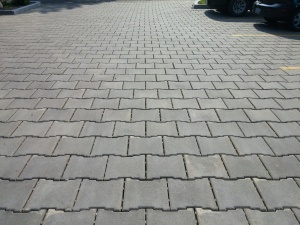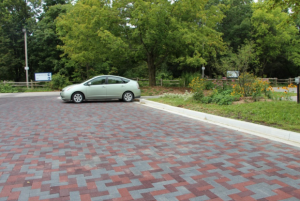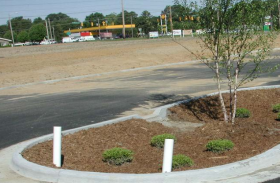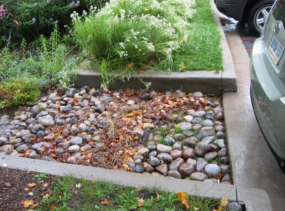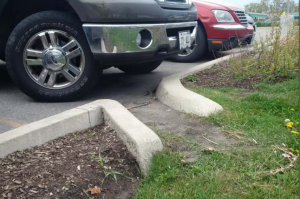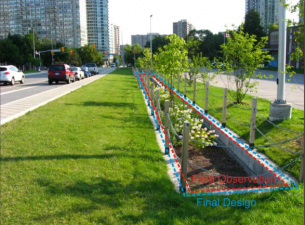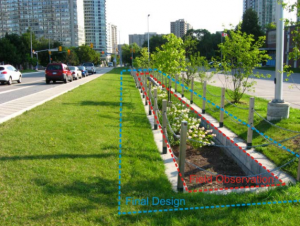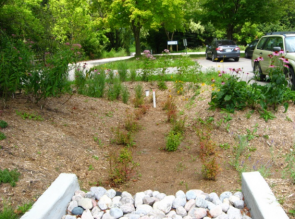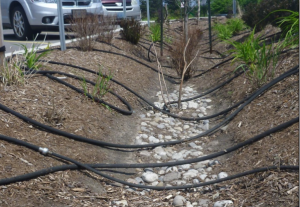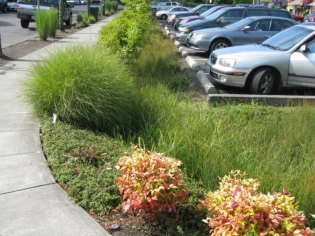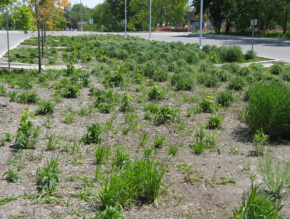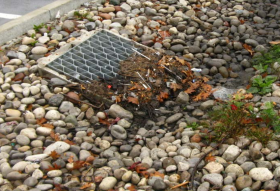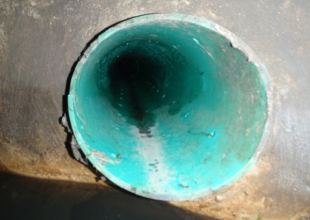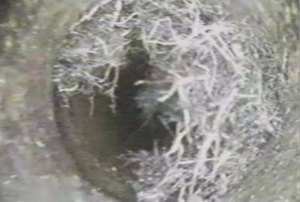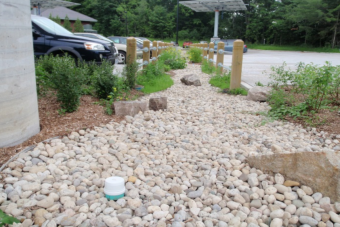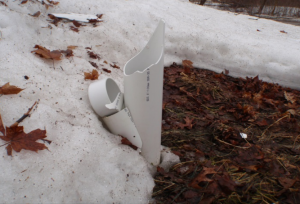Difference between revisions of "Inspection and Maintenance: Permeable Pavement"
| Line 229: | Line 229: | ||
| | | | ||
|- | |- | ||
|} | |||
==Routine Maintenance - Key Components and I&M Tasks== | |||
Regular inspections (twice annually, at a minimum) done as part of routine maintenance tasks over the operating phase of the BMP life cycle to determine if maintenance task frequencies are adequate and determine when rehabilitation or further investigations into BMP function are warranted. | |||
Table below describes routine maintenance tasks for [[bioretention]] practices, organized by BMP component, along with recommended minimum frequencies. It also suggests higher frequencies for certain tasks that may be warranted for BMPs located in highly visible locations or those receiving flow from high traffic areas (vehicle or pedestrian). Tasks involving removal of trash, debris and sediment and weeding/trimming of [[vegetation]] for BMPs in such contexts may need to be done more frequently (i.e., higher standards may be warranted). | |||
Individuals conducting [[vegetation]] maintenance and in particular, weeding (i.e., removal of undesirable vegetation), should be familiar with the species of [[Plant lists|plants]] specified in the planting plan and experienced in plant identification and methods of removing/controlling noxious weeds. Key resources on these topics are provided below at the links provided: | |||
*[http://www.weedinfo.ca/en/ Agriculture and Agri-food Canada’s Weed Info database] | |||
*[http://www.omafra.gov.on.ca/english/crops/facts/ontweeds/weedgal.htm Ontario Ministry of Agriculture, Food and Rural Affairs’ Ontario Weed Gallery] | |||
*[http://www.omafra.gov.on.ca/english/crops/facts/noxious_weeds.htm Ontario Ministry of Agriculture, Food and Rural Affairs’ Noxious Weeds In Ontario list] | |||
*[https://www.ontarioinvasiveplants.ca/wp-content/uploads/2016/07/QRG_FINAL.pdf Ontario Invasive Plant Council’s Quick Reference Guide to Invasive Plant Species] | |||
*[https://wrrc.arizona.edu/sites/wrrc.arizona.edu/files/OSU_Field%20Guide%20-%20Maintaining%20Rain%20Gardens%2C%20Swales%2C%20and%20Stormwater%20Planters.pdf Oregon State University Stormwater Solutions, 2013, Field Guide: Maintaining Rain Gardens, Swales and Stormwater Planters, Corvallis, OR.] | |||
*[https://lonepinebooks.com/product/plants-of-southern-ontario-2/ Plants of Southern Ontario (book), 2014, by Richard Dickinson and France Royer, Lone Pine Publishing, 528 pgs.] | |||
*[http://www.agrifs.ir/sites/default/files/Weeds%20of%20North%20America%20%7BRichard%20Dickinson%7D%20%5B9780226076447%5D%20%282014%29_2.pdf Weeds of North America (book), 2014, by Richard Dickinson and France Royer, University of Chicago Press, 656 pgs.] | |||
{|class="wikitable" style="width: 1280px" | |||
|+'''Bioretention/Swales: Key Components, Descriptions and Routine I&M Requirements''' | |||
|- | |||
!style="width: 500px"|Comnponent | |||
!style="width: 1500px"|Description | |||
!style="width: 1500px"|Inspection & Maintenance Tasks | |||
!style="width: 500px"|<span style="color:green">('''Pass''')</span> Photo Example | |||
!style="width: 550px"|<span style="color:red">('''Fail''')</span> Photo Example | |||
|- | |||
|'''[[Bioretention: Sizing|Contributing Drainage Area (CDA)]]''' | |||
| | |||
Area(s) from which runoff directed to the BMP originates; includes both impervious and pervious areas. | |||
| | |||
*Remove trash, debris and sediment from pavements (biannually to quarterly) and eavestroughs (annually); | |||
*Replant or seed bare soil areas as needed. | |||
|[[File:Pass.PNG|300px|thumb|center|CDA has not changed in size or land cover. Sediment, trash or debris is not accumulating and point sources of contaminants are not visible.]] | |||
|[[File:Fail bio.PNG|280px|thumb|center|Size of the CDA has changed from design assumptions. A point source for contaminants is visible (i.e. lack of sediment controls on adjacent construction site). (Photo Source: North Carolina Cooperative Extension)]] | |||
|- | |||
|'''[[Pretreatment]]''' | |||
| | |||
Devices or features that retain trash, debris and sediment; help to extend the [[Cost analysis resources|operating life cycle]]; examples are eavestrough screens, [[Pretreatment|catch basin]] inserts and sumps, [[oil and grit separators]], [[inlets|geotextile-lined inlets]], [[Gravel diaphragms|gravel trenches]], [[Vegetated filter strips|grass filter strips]] and [[forebays]]. | |||
| | |||
*Remove trash, debris and sediment annually to biannually or when the device sump is half full; | |||
*Measure sediment depth or volume during each cleaning, or annually to estimate accumulation rate and optimize frequency of maintenance | |||
|[[File:Pretreatment pass bio.PNG|310px|thumb|center|[[Forebay]] is free of sediment, trash and debris and recently maintained. The large stones in the feature are used to slow down and spread out inflowing water into the feature and they remain well arranged and in place.]] | |||
|[[File:Pretreatment fail bio.PNG|290px|thumb|center|An erosion gully occurring where bare soil is starting to become visible on the [[Vegetated filter strips|grass filter strip]] pretreatment feature at the inlet, thus indicating it is not effectively slowing and spreading out the inflow of stormwater to the BMP.]] | |||
|- | |||
|'''[[Inlets]]''' | |||
| | |||
Structures that deliver water to the BMP (e.g., [[Curb cuts]], [[inlets|spillways]], pavement edges, [[inlets|catch basins]], [[pipes]]). | |||
| | |||
*Keep free of obstructions; | |||
*Remove trash, debris and sediment biannually to quarterly; | |||
*Measure sediment depth or volume during each cleaning or annually to estimate accumulation rate and optimize frequency of maintenance; | |||
*Remove woody [[vegetation]] from filter bed at [[inlets]] annually. | |||
|[[File:Inlets bio pass.PNG|285px|thumb|center|There is no evidence of damage or displacement of the inlet structure that would prevent runoff from freely entering the BMP.]] | |||
|[[File:Inlets bio fail.PNG|300px|thumb|center|Accumulated sediment and vegetation is preventing stormwater from entering the BMP. Sediment on the pavement surface in front of the inlet indicates ponding is also occurring]] | |||
|- | |||
|'''Perimeter''' | |||
| | |||
Side slopes or structures that define the BMP footprint; may be covered by a mixture of [[vegetation]], [[mulch]] and [[stone]] with slopes up to 2:1 (H:V), or concrete or masonry structures with vertical walls. | |||
| | |||
*Confirm the surface ponding footprint area dimensions are within ±10% of the design and that maximum surface ponding depth meets design specifications; | |||
*Check for side slope erosion or damage that compromises water storage capacity | |||
|[[File:Perimeter bio pass.PNG|305px|thumb|center|The footprint area of the bioretention cell does not significantly deviate from the final design and should not negatively affect its stormwater management treatment performance.]] | |||
|[[File:Perimeter bio fail.PNG|300px|thumb|center|The footprint area of the BMP is significantly smaller than what was specified in the final design of this example and differ greater than the recommended SWM criteria requirements (>10%).]] | |||
|- | |||
|'''[[Bioretention: Construction checklist|Filter Bed]]''' | |||
| | |||
Flat or gently sloping area composed of a 0.5 to 1 m deep layer of [[filter media]] soil covered by a mixture of [[vegetation]], [[mulch]] and [[stone]] where [[Bioretention: TTT|surface ponding]] and filtration of runoff occurs. | |||
| | |||
*Check for standing water, barren/eroded areas, sinkholes or animal burrows; | |||
*Remove trash biannually to quarterly; | |||
*Rake regularly to redistribute [[mulch]] and prevent sediment crusts; | |||
*Maintain 5 to 10 cm of mulch or stone cover to prevent weed growth and soil [[erosion]]; | |||
*Repair sunken areas when ≥ 10 cm deep and barren/eroded areas when ≥ 30 cm long; | |||
*Remove sediment when > 5 cm deep or time to drain water ponded on the surface exceeds 48 hours. | |||
|[[File:Filter bed bio pass.PNG|295px|thumb|center|There are no erosion gullies or bare soil areas on the filter bed surface and mulch cover remains in place.]] | |||
|[[File:Filter bed bio fail.PNG|300px|thumb|center|Erosion gullies and bare soil areas are present on the filter bed surface, indicating that concentrated flow occurs regularly into the BMP feature. (Photo Source: CVC).]] | |||
|- | |||
|'''[[Vegetation]]''' | |||
| | |||
A mixture of deep rooting perennial plants, tolerant to both wet and dry conditions and salt (if receiving pavement runoff); can include grasses, flowers, shrubs and trees; roots uptake water and return it to the atmosphere; provide habitat for organisms that break down trapped pollutants and help maintain soil structure and permeability. | |||
| | |||
*Routine maintenance is the same as a conventional perennial garden bed; | |||
*In the first 2 months water plantings frequently (biweekly in the absence or rain) and as needed (e.g., bimonthly) over the remainder of the first growing season; | |||
*Remove weeds and undesirable plants biannually to quarterly; | |||
*Replace dead plantings annually to achieve 80% cover by the third growing season; | |||
*Do not apply chemical fertilizers. | |||
|[[File:Vegetation bio pass.PNG|315px|thumb|center|The planted portion of the bioretention cell is completely covered with dense, attractive vegetation which helps to maintain its stormwater treatment function and aesthetic value.]] | |||
|[[File:Vegetation bio fail .PNG|290px|thumb|center|A larger portion of the bioretention cell has no vegetation cover which reduces its aesthetic value and could be negatively affecting its stormwater treatment function. Much less than 80% of the planting area is covered by living vegetation requiring immediate maintenance and reseeding.]] | |||
|- | |||
|'''[[Overflow|Overflow Outlet]]''' | |||
| | |||
Structures that convey overflows to another BMP or municipal storm sewer. | |||
| | |||
*Keep free of obstructions; | |||
*Remove trash, debris and sediment biannually to quarterly. | |||
|[[File:Overflow bio pass.PNG|320px|thumb|center|The overflow outlet is free of damage and obstruction and functions as originally designed.]] | |||
|[[File:Overflow bio fail.PNG|280px|thumb|center|The overflow outlet is partially obstructed with trash and debris which reduces its capacity to safely convey excess water from the BMP, likely due to excess ponding thus obstructing outflow and impairing overall drainage function of the BMP.]] | |||
|- | |||
|'''[[Underdrain|Sub-drain]]''' | |||
| | |||
Optional component; [[Pipes|perforated pipe(s)]] surrounded by [[gravel]] and may be wrapped in [[Geotextile|geotextile filter fabric]]; installed below the [[filter media]] soil layer to collect and convey treated water to an adjacent drainage system; may also include a flow restrictor. | |||
| | |||
*Include [[Bioretention: Sizing|standpipes]] or access points to provide means of flushing the [[perforated pipe]]; | |||
*Keep pipe and flow restrictor free of obstructions by flushing annually; | |||
*Inspect flow restrictor frequently (e.g., biannually to quarterly). | |||
|[[File:Underdrain bio pass.PNG|310px|thumb|center|The perforated sub-drain pipe is not obstructed by sediment, debris or roots and shows no signs of damage.]] | |||
|[[File:Underdrain bio fail.PNG|300px|thumb|center|Roots have penetrated the underdrain/sub-drain pipe and are substantially reducing its conveyance capacity. Structural damage, sediment/debris clogs or vegetation roots are visible and are reducing the conveyance capacity of the pipe by one third (33%) or more. (Photo Source: Pipelining Denver)]] | |||
|- | |||
|'''[[Monitoring well]]''' | |||
| | |||
[[Wells|Perforated standpipe]] that extends from the bottom of the BMP to above the invert of the [[Overflow|overflow outlet]]. Allows [[Digital technologies|measurement of subsurface water level]] to track drainage performance over time. | |||
| | |||
*[[Wells|Standpipes]] should be securely capped on both ends and remain undamaged. | |||
|[[File:MonitoringWell bio pass.PNG|340px|thumb|center|The well is undamaged and accessible and the cap is in place and secured to prevent unauthorized access.]] | |||
|[[File:MonitoringWell bio fail.PNG|300px|thumb|center|The well standpipe has been damaged by snow plowing, which impairs its use for monitoring and is a safety hazard. With the cap unable to be secured unauthorized access can also occur.]] | |||
|} | |} | ||
Revision as of 15:00, 20 July 2022
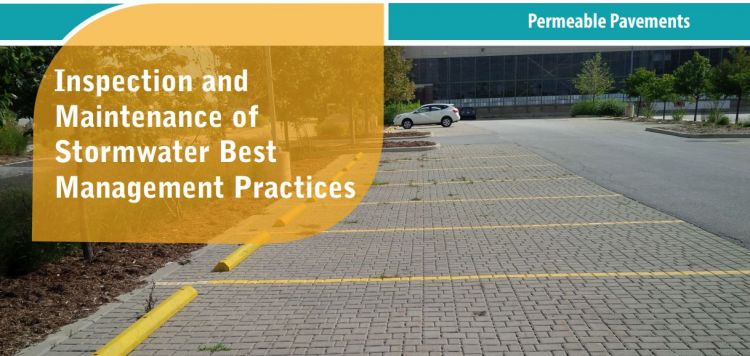
Overview[edit]
Permeable Pavement Permeable pavements contain many small openings (i.e., joints or pores) that allow rainfall and snowmelt (i.e., stormwater) to drain through them instead of running off the surface as it does on impervious pavements like conventional asphalt and concrete. An overflow outlet is needed to safely convey flows during flood events. Depending on the permeability of the underlying soil and other constraints, the pavement may be designed with no sub-drain for full infiltration, with a sub-drain for partial infiltration, or with an impermeable liner and sub-drain for a no infiltration practice. The sub-drain pipe may feature a flow restrictor (e.g., orifice cap or valve) for gradually releasing detained water and optimizing the amount drained by infiltration into the underlying soil.
Key components of Permeable pavements to pay close attention to are the:
Associated Practices[edit]
- Permeable Interlocking Pavers (i.e., Block Pavers) – Precast modular units made of concrete, pervious concrete or rubber/plastic composite designed to create open joints between pavers that are filled with fine, washed aggregate and installed on an open graded aggregate (i.e., clear stone) base and sub-base.
- Permeable Interlocking Grid Systems (i.e., grid pavers) – Precast concrete or manufactured plastic grids with open cells that can be filled with aggregate or a mixture of sand, gravel and topsoil and planted with grass or low-growing ground covers and are installed on an open-graded aggregate base.
- Pervious Concrete – a rigid pavement installed on an open-graded aggregate base that uses a cementitious binder to adhere aggregate together, similar to conventional concrete, except that the fine aggregate component is minimized or eliminated which results in the formation of connected pores throughout.
- Porous Asphalt – a flexible pavement installed on an open-graded aggregate base that uses a bituminous binder to adhere aggregate together, similar to conventional asphalt, except that the fine aggregate component is minimized or eliminated which results in the formation of connected pores throughout.
Inspection and Testing Framework[edit]
Component |
Indicators |
Construction Inspection |
Assumption Inspection |
Routine Operation Inspection |
Verification Inspection |
|---|---|---|---|---|---|
| Contributing Drainage Area | |||||
| CDA condition | x | x | x | x | |
| Perimeter | |||||
| BMP dimensions | x | x | x | ||
| Filter Bed | |||||
| Standing water | x | x | x | ||
| Trash | x | x | |||
| Vegetation | |||||
| Vegetation cover | x | x | x | x | |
| Vegetation condition | x | x | |||
| Vegetation composition | x | x | x | ||
| Underdrain & Monitoring Well | |||||
| Monitoring well condition | x | x | x | x | |
| Sub-drain/Perforated pipe obstruction | x | x | |||
| Outlets | Overflow outlet obstruction | x | x | x | x |
| Pavement Surface | Pavement surface condition | x | x | ||
| Pavement surface sediment accumulation | x | x | x | x | |
| Control structure condition | x | x | x | x | |
| Control structure sediment accumulation | x | x | x | x |
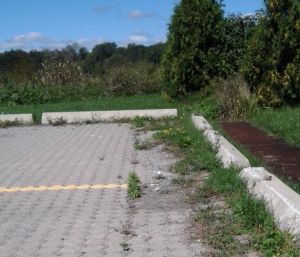
Component |
Indicators |
Construction Inspection |
Assumption Inspection |
Routine Operation Inspection |
Verification Inspection | |
|---|---|---|---|---|---|---|
| Testing Indicators | ||||||
| Surface infiltration rate testing | x | (x) | ||||
| Natural or simulated storm event testing | x | (x) | ||||
| Continuous monitoring | x | (x) | ||||
| Note: (x) denotes indicators to be used for Performance Verification inspections only (i.e., not for Maintenance Verification inspections) | ||||||
Construction Inspection Tasks[edit]
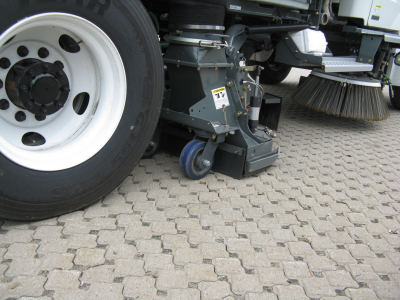
Construction inspections take place during several points in the construction sequence, specific to the type of LID BMP, but at a minimum should be done weekly and include the following:
- During site preparation, prior to BMP excavation and grading to ensure the CDA is stabilized and/or flow diversion devices are in place and confirm that construction materials meet design specifications
- At completion of excavation and grading, prior to backfilling and installation of pipes to ensure depths, slopes and elevations are acceptable
- At completion of installation of pipes, prior to completion of backfilling to ensure slopes and elevations are acceptable
- After final grading, prior to surface course installation to ensure depths, slopes and elevations are acceptable
- Prior to hand-off points in the construction sequence when the contractor responsible for the work changes (i.e., hand-offs between the storm sewer servicing, paving, building and landscaping contractors)
- After every large storm event (e.g., 15 mm rainfall depth or greater) to ensure flow diversion devices are functioning and adequately maintained. View the table below, which describes critical points during the construction sequence when inspections should be performed prior to proceeding further. You can also download and print the table here
Construction Sequence Step & Timing |
Inspection Item |
Observations* |
|---|---|---|
| Site Preparation - after site clearing and grading, prior to BMP excavation and grading | Natural heritage system and tree protection areas remain fenced off | |
| ESCs protecting BMP layout area are installed properly | ||
| CDA is stabilized or runoff is diverted around BMP layout area | ||
| BMP layout area has been cleared and is staked/delineated | ||
| Benchmark elevation(s) are established nearby | ||
| Construction materials have been confirmed to meet design specifications | ||
| BMP Excavation and Grading - prior to backfilling and installation of pipes/catchbasins | Excavated soil is stockpiled outside the CDA | |
| Excavation location, footprint, depth and slope are acceptable | ||
| BMP Installation – after installation of pipes/catchbasins, prior to completion of backfilling | Structural components (e.g., pavement base, curbs) installation is acceptable | |
| Impermeable liner installed correctly, if applicable | ||
| Installations of sub-drain pipes (e.g., locations, elevations, slopes), standpipes/monitoring wells are acceptable | ||
| Sub-drain trench dams installed correctly (location, elevation) | ||
| Surface coarse installation (elevation, slope, monitoring wells) is acceptable |
Routine Maintenance - Key Components and I&M Tasks[edit]
Regular inspections (twice annually, at a minimum) done as part of routine maintenance tasks over the operating phase of the BMP life cycle to determine if maintenance task frequencies are adequate and determine when rehabilitation or further investigations into BMP function are warranted.
Table below describes routine maintenance tasks for bioretention practices, organized by BMP component, along with recommended minimum frequencies. It also suggests higher frequencies for certain tasks that may be warranted for BMPs located in highly visible locations or those receiving flow from high traffic areas (vehicle or pedestrian). Tasks involving removal of trash, debris and sediment and weeding/trimming of vegetation for BMPs in such contexts may need to be done more frequently (i.e., higher standards may be warranted).
Individuals conducting vegetation maintenance and in particular, weeding (i.e., removal of undesirable vegetation), should be familiar with the species of plants specified in the planting plan and experienced in plant identification and methods of removing/controlling noxious weeds. Key resources on these topics are provided below at the links provided:
- Agriculture and Agri-food Canada’s Weed Info database
- Ontario Ministry of Agriculture, Food and Rural Affairs’ Ontario Weed Gallery
- Ontario Ministry of Agriculture, Food and Rural Affairs’ Noxious Weeds In Ontario list
- Ontario Invasive Plant Council’s Quick Reference Guide to Invasive Plant Species
- Oregon State University Stormwater Solutions, 2013, Field Guide: Maintaining Rain Gardens, Swales and Stormwater Planters, Corvallis, OR.
- Plants of Southern Ontario (book), 2014, by Richard Dickinson and France Royer, Lone Pine Publishing, 528 pgs.
- Weeds of North America (book), 2014, by Richard Dickinson and France Royer, University of Chicago Press, 656 pgs.
| Comnponent | Description | Inspection & Maintenance Tasks | (Pass) Photo Example | (Fail) Photo Example |
|---|---|---|---|---|
| Contributing Drainage Area (CDA) |
Area(s) from which runoff directed to the BMP originates; includes both impervious and pervious areas. |
|
||
| Pretreatment |
Devices or features that retain trash, debris and sediment; help to extend the operating life cycle; examples are eavestrough screens, catch basin inserts and sumps, oil and grit separators, geotextile-lined inlets, gravel trenches, grass filter strips and forebays. |
|
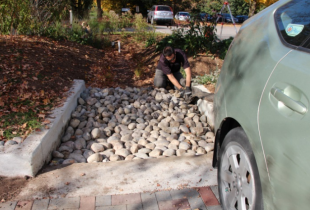 Forebay is free of sediment, trash and debris and recently maintained. The large stones in the feature are used to slow down and spread out inflowing water into the feature and they remain well arranged and in place. |
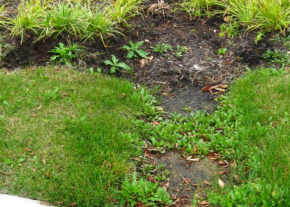 An erosion gully occurring where bare soil is starting to become visible on the grass filter strip pretreatment feature at the inlet, thus indicating it is not effectively slowing and spreading out the inflow of stormwater to the BMP. |
| Inlets |
Structures that deliver water to the BMP (e.g., Curb cuts, spillways, pavement edges, catch basins, pipes). |
|
||
| Perimeter |
Side slopes or structures that define the BMP footprint; may be covered by a mixture of vegetation, mulch and stone with slopes up to 2:1 (H:V), or concrete or masonry structures with vertical walls. |
|
||
| Filter Bed |
Flat or gently sloping area composed of a 0.5 to 1 m deep layer of filter media soil covered by a mixture of vegetation, mulch and stone where surface ponding and filtration of runoff occurs. |
|
||
| Vegetation |
A mixture of deep rooting perennial plants, tolerant to both wet and dry conditions and salt (if receiving pavement runoff); can include grasses, flowers, shrubs and trees; roots uptake water and return it to the atmosphere; provide habitat for organisms that break down trapped pollutants and help maintain soil structure and permeability. |
|
||
| Overflow Outlet |
Structures that convey overflows to another BMP or municipal storm sewer. |
|
||
| Sub-drain |
Optional component; perforated pipe(s) surrounded by gravel and may be wrapped in geotextile filter fabric; installed below the filter media soil layer to collect and convey treated water to an adjacent drainage system; may also include a flow restrictor. |
|
||
| Monitoring well |
Perforated standpipe that extends from the bottom of the BMP to above the invert of the overflow outlet. Allows measurement of subsurface water level to track drainage performance over time. |
|
- ↑ TRCA. 2016. Fact Sheet - Inspection and Maintenance of Stormwater Best Management Practices: Permeable Pavement. https://sustainabletechnologies.ca/app/uploads/2018/02/Permeable-Pavement-Fact-Sheet.pdf
- ↑ STEP. 2018. Fact Sheet - Inspection and Maintenance of Stormwater Best Management Practices: Permeable Pavements. https://sustainabletechnologies.ca/app/uploads/2018/02/Permeable-Pavement-Fact-Sheet.pdf
